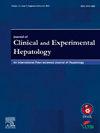微创供肝切除术
IF 3.3
Q2 GASTROENTEROLOGY & HEPATOLOGY
Journal of Clinical and Experimental Hepatology
Pub Date : 2025-02-19
DOI:10.1016/j.jceh.2025.102516
引用次数: 0
摘要
微创供肝切除术(MIDH)包括腹腔镜或机器人辅助技术,通过远程切口取出移植物。目前的证据表明,MIDH术后比开放供肝切除术恢复更快,生活质量更好,尽管这些仅限于少数大容量移植中心。尽管如此,通过MIDH获得的移植物有一个轻微的缺点,即静脉长度比开放的移植物短。此外,胆道并发症在腹腔镜技术移植的受者中更为普遍,而机器人平台移植的受者胆道并发症发生率与开放供肝切除术相当,甚至更好。MIDH在世界范围内仍未得到广泛应用。本文探讨了移植外科医生从开放供肝切除术过渡到MIDH(机器人供肝切除术的标准技术)时所面临的挑战,并提出了克服学习曲线的策略。它比较了腹腔镜和机器人供肝切除术,详细介绍了每种方法的优缺点,以及它们的结果。本文章由计算机程序翻译,如有差异,请以英文原文为准。
Minimally Invasive Donor Hepatectomy
Minimally invasive donor hepatectomy (MIDH) involves either laparoscopic or robot-assisted technique, with the graft being retrieved through a remote incision. Current evidence reports faster recovery and better quality of life following MIDH than open donor hepatectomy, although these are limited to a handful of high-volume transplant centers. Nonetheless, grafts obtained by MIDH have a slight disadvantage of having shorter vein lengths than its open counterpart. Additionally, biliary complications are more prevalent in recipients of grafts retrieved by laparoscopic technique, while those obtained by the robotic platform demonstrate biliary complication rates comparable to, or even better than, those from open donor hepatectomy. Widespread application of MIDH has still not occurred across the world. This narrative review explores the challenges faced by the transplant surgeons when transitioning from open donor hepatectomy to MIDH, standard technique of robotic donor hepatectomy and suggests strategies to overcome the learning curve. It compares laparoscopic and robotic donor hepatectomies, detailing the advantages and disadvantages of each approach, as well as their outcomes.
求助全文
通过发布文献求助,成功后即可免费获取论文全文。
去求助
来源期刊

Journal of Clinical and Experimental Hepatology
GASTROENTEROLOGY & HEPATOLOGY-
CiteScore
4.90
自引率
16.70%
发文量
537
审稿时长
64 days
 求助内容:
求助内容: 应助结果提醒方式:
应助结果提醒方式:


